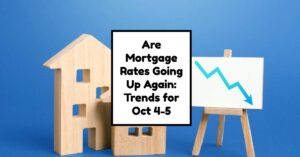
Are today's mortgage rates heading up or down? It's a question on everyone's mind, and the answer, as you might expect, isn't a simple yes or no.
Are Mortgage Rates Going Up Again: Trends for Oct 4-5, 2024
Think of mortgage rates like a rollercoaster. They’re constantly moving, influenced by a bunch of things. The biggest player? The Federal Reserve (the Fed). The Fed controls interest rates, and these influence what lenders charge for mortgages. When the Fed lowers rates (like they did recently), it usually means lower mortgage rates for you and me. But it's not that simple.

Another big factor? Investor confidence in the economy. If investors think the economy is strong, they might buy more Treasury bonds, which drives up the yield on those bonds. This, in turn, often pushes mortgage rates higher. Conversely, if investors are worried, they might pull back, leading to lower mortgage rates. It’s a complex dance, but understanding the key players helps you navigate the market.
Current Mortgage Rate Snapshot (October 4, 2024)
According to Bankrate data, as of October 4th, 2024, mortgage rates showed a slight increase across the board compared to the previous week. Here’s the breakdown:
| Mortgage Type | Today's Rate | Last Week's Rate | Change |
|---|---|---|---|
| 30-Year Fixed | 6.23% | 6.22% | +0.01% |
| 15-Year Fixed | 5.48% | 5.38% | +0.10% |
| 5/1 ARM | 5.89% | 5.80% | +0.09% |
| 30-Year Fixed Jumbo | 6.41% | 6.35% | +0.06% |
| 30-Year Fixed Refinance | 6.21% | 6.19% | +0.02% |
Note: These are average rates. Your actual rate will depend on your credit score, down payment, and the type of loan you choose.
What's Behind These Recent Rate Hikes?
The slight increase in rates this past week might be due to a number of things. While the Fed did recently cut rates, the market is always reacting to new economic data and investor sentiment. Even a small shift in the economy can cause ripples in the mortgage market. Remember, the relationship between Fed decisions and mortgage rates isn't direct. There's always a bit of a lag and other factors at play.
The 30-Year Fixed Mortgage: A Deep Dive
The 30-year fixed mortgage is the most popular choice for many homebuyers. It offers predictable monthly payments, which is comforting. However, there's a trade-off. Let's look at the pros and cons:
Pros:
- Predictable monthly payments: Budgeting becomes easier.
- Lower monthly payments: Compared to shorter-term loans, your monthly payment is smaller.
Cons:
- More interest paid over time: You'll pay significantly more in interest over the life of the loan.
- Slower equity growth: A bigger chunk of your early payments goes towards interest, leaving less to pay down the principal.
15-Year Fixed Mortgage: A Faster Track
A 15-year fixed mortgage comes with higher monthly payments, but it pays off much faster. This means you'll pay significantly less interest overall and build equity quicker. It's a great option if you can manage the higher monthly payments.
Adjustable-Rate Mortgages (ARMs): The Risky Choice
ARMs have a fixed interest rate for a set period (like five years in a 5/1 ARM), after which the rate adjusts periodically. While they might offer lower initial rates, they carry more risk. If interest rates rise, your monthly payments could jump significantly.
Jumbo Loans: For High-End Purchases
Jumbo loans are for homes exceeding the conforming loan limit set by Fannie Mae and Freddie Mac. These loans often come with higher interest rates and stricter qualification requirements.
What to Expect in the Coming Months:
Predicting mortgage rates is never an exact science. However, with the Fed currently cutting rates and inflation showing signs of slowing, it's likely we will see lower mortgage rates in the coming months. But don't expect a dramatic plunge. It’s likely to be a gradual decline. Keep your eyes on economic indicators and the Fed's announcements for clues.
Should You Wait or Buy Now?
This is the million-dollar question! The decision depends on your personal circumstances. If you’re comfortable waiting for potentially lower rates, that's an option. But if you need to buy now, don't get paralyzed by waiting for the “perfect” rate. Remember, rates are just one piece of the home-buying puzzle. You'll also need to factor in home prices, your financial situation, and your personal comfort level with debt.
My Personal Take:
While we might see lower rates soon, it's best to prepare for some continued volatility. Don't solely rely on forecasts. Talk to a mortgage professional; they can help you analyze your financial picture and suggest the best course of action for your situation. It's their job to stay up-to-date on market trends.
Tips for Finding the Best Mortgage Rate:
- Shop around: Get quotes from multiple lenders.
- Improve your credit score: A higher credit score often qualifies you for better rates.
- Make a larger down payment: This can significantly reduce your rate.
The Bottom Line
Today's mortgage rates saw a slight uptick compared to the previous week, but the overall trend is influenced by many things. While the Fed's recent rate cuts suggest a potential downward trajectory for mortgage rates, it's not a guarantee. The best advice? Stay informed, shop around, and talk to a mortgage professional for personalized advice.
Related Articles:
- Prediction: Why Mortgage Rates Won’t Go Below 6% in 2024?
- Will Mortgage Rates Ever Be 3% Again: Future Outlook
- Mortgage Rates Predictions for Next 2 Years
- Mortgage Rate Predictions for Next 5 Years
- Mortgage Rate Predictions for 2025: Expert Forecast
- Prediction: Interest Rates Falling Below 6% Will Explode the Housing Market
- Mortgage Rate Predictions: Why 2% and 3% Rates are Out of Reach
- How Lower Mortgage Rates Can Save You Thousands?
- How to Get a Low Mortgage Interest Rate?
- Will Mortgage Rates Ever Be 4% Again?


